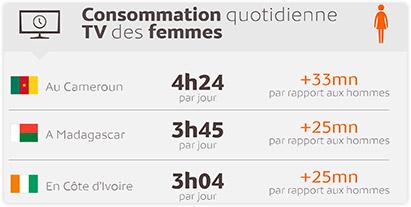Which medium is most popular amongst women?

|
Just as for many markets across the world, women are a target of choice for marketing professionals. Although African women are becoming more and more emancipated, they still retain their essential role in decisions about household purchases, starting with food. So, it is not a surprise that major advertisers have an increasing need for research and benchmarks to find out which media to prioritise in order to hone in on this invaluable target. |

In this pursuit, television is considered as an indispensable medium with a higher number of female than male viewers and with women watching for longer than their male counterparts.
In late 2016, Ivorian women spent 3 hours and 4 minutes watching television, which was 25 minutes longer than men; women spent 33 minutes longer watching television than men in Cameroon with 4 hours and 24 minutes spent in front of the screen, 5 minutes longer than men in Senegal with 2 hours and 44 minutes, and finally, 25 minutes longer in Madagascar with 3 hours and 45 minutes.
Of course, not all channels are equally alluring to women and, while this is increasingly asserting the equality between the sexes, women are not yet at the stage where they are hijacking the remote control so they can watch a football match or a magazine show about cars!
No, they are generally happiest when watching general interest channels and channels with a rich and high-quality fiction or series offering, be it produced internationally, locally or elsewhere in Africa.
So, on channels such as Novelas TV or Nollywood TV, females account for over 70% of the audience compared with only 30% of men.
Another well-known fact: women have highly specific behaviours which contrast sharply with the behaviour of an average viewer. So, although the 8pm news is, on average, the audience peak of the day for television viewers as a whole, women will instead tend to concentrate their viewing either in the Prime Time Access slot in Côte d’Ivoire, with a peak between 7pm and 7.30pm, or in the first part of the evening just after the end of the news in Senegal, with a peak at 9pm.
Television laughs along with women… but radio cries without them! Conversely, men are very much drawn towards Radio, but it is nowhere near as popular amongst women. Radio – even though it is considered with advertising as the last medium before a purchase – is not as successful at attracting women. So, what is the reason behind this? It is probably due to a combination of factors such as devices, access to private cars (one of the locations with the highest radio audience) or the very nature of the radio offering itself.
However, let's avoid any clichés! Each medium has its own particular power and affinity, and if certain content hits its target in the bullseye, it is a safe bet that the advertising messages derive all of the anticipated effectiveness from it. There you go, efficiency is a trait that is commonly associated with women!
Sources: Médiamétrie – Media Research Africa – Sept-Nov 2016. Contact : Houda Bakkali, Director of Research and Clientele, hbakkali@mediametrie.fr
Test of significance of the differences between two proportions
Used to assess whether the difference between 2 proportions is significant at the 95% threshold
Warning: only applies to a proportion. The Average Rate is an average of proportions and the Audience Share a ratio of proportions. This tool is provided for information purposes. It cannot be applied for professional purposes without further precautions.
des médias
edition
definitions